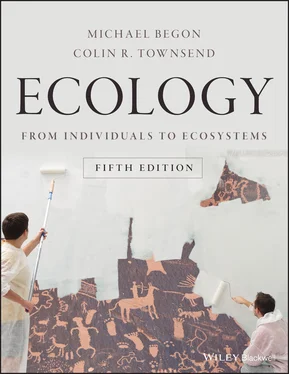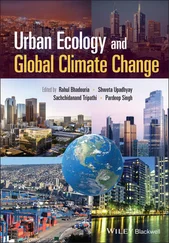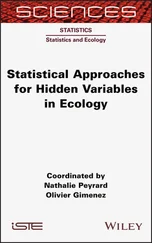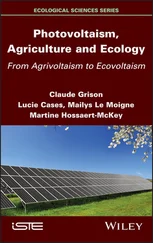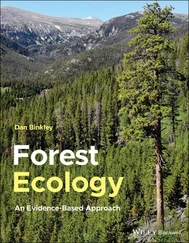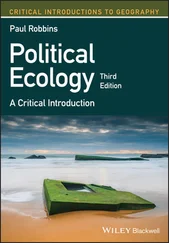pigment variation in aquatic species
In aquatic habitats, much of the variation between species is accounted for by differences in photosynthetic pigments, which contribute significantly to the precise wavelengths of radiation that can be utilised. Of the three types of pigment – chlorophylls, carotenoids and biliproteins – all photosynthetic plants contain the first two, but many algae also contain biliproteins; and within the chlorophylls, all higher plants have chlorophyll a and b, but many algae have only chlorophyll a and some have chlorophyll a and c. These different forms of chlorophyll all have slightly different absorption spectra, so that in combination, the plant or alga can trap more light. We see an example of variation in the nature of light with the concentration of dissolved organic matter in lake water, and the consequences of this for the photosynthetic microphytoplankton living there, in Figure 3.6. Of two lakes in north‐western Patagonia, Argentina, one, Lake Morenito, had lower concentrations of dissolved organic matter, leading to ‘greener’ light ( Figure 3.6a) and hence to higher densities of cryptophyte algae ( Figure 3.6b). Cryptophytes have a unique combination of pigments – chlorophylls a and c, but also the carotenoid alloxanthin and one of two biliproteins – allowing them to function effectively in that range. The other, Lake Escondido, with yellower light, had a microphytoplankton community dominated by chrysophytes (‘golden algae’), which lack these biliproteins.

Figure 3.6 Variation in light quality in lakes can give rise to different communities of photosynthesisers.(a) The mean spectrum (wavelength distribution) of downward irradiance in the water columns of two lakes in Argentina: Lake Escondido and Lake Morenito. (b) As a result of the greener light in Lake Morenito, it supported a phytoplankton community with a higher proportion of cryptophytes that have photosynthetic pigments enabling them to function effectively at such wavelengths.
Source : After Gerea et al . (2017).
the compensation point
Photosynthesis is measured as CO 2uptake, which is roughly proportional to the amount of organic matter formed by the plant or alga, and in turn to the energy captured in that organic matter. However, it is often more important to consider, and very much easier to measure, the net gain. Net photosynthesis is the increase (or decrease) in dry matter that results from the difference between gross photosynthesis and the contemporary losses due to respiration. The light compensation point is the intensity of PAR at which the gain from gross photosynthesis exactly balances these respiratory losses. Hence, net photosynthesis increases with the intensity of PAR, and is negative below the compensation point (including, of course, in darkness), when respiration exceeds photosynthesis. An example of the way plant characteristics combine to determine the compensation point is shown in Figure 3.7. As seedlings of sugar maple ( Acer saccharum ) grow, the proportion of non‐photosynthetically active stem tissue to photosynthetically active leaf tissue increases, and the degree of self‐shading (upper leaves denying light to lower leaves) increases. Hence, at a given light level, taller (older) plants photosynthesise less effectively and their net carbon gain per gram of plant tissue declines ( Figure 3.7a). As a consequence of this, while growing taller is often advantageous (for example, in terms of intercepting light before some other plant does) the compensation point increases in taller plants – they require more light to balance their respiratory needs ( Figure 3.7b).

Figure 3.7 The compensation point is higher in taller plants.(a) The decline in the estimated above‐ground net daily carbon gain (effectiveness of photosynthesis) with height for seedlings of sugar maple, Acer saccharum . (b) The consequent increase in the above‐ground light compensation point for seedlings with height. PPFD, photosynthetic photon flux density.
Source : After Sendall et al . (2015).
photosynthetic capacity
There is nearly a 100‐fold variation in the photosynthetic capacity of leaves (Mooney & Gulmon, 1979). This is the rate of photosynthesis when incident radiation is saturating, temperature is optimal, relative humidity is high, and CO 2and oxygen concentrations are normal. When the leaves of different species are compared under these ideal conditions, the ones with the highest photosynthetic capacity are generally those from environments where nutrients, water and radiation are seldom limiting (at least during the growing season). These include many agricultural crops and their weeds, and also the primary colonisers of newly available rich habitats, for example volcanic ash, or the grass, Echinochloa polystachya , on Amazonian floodplains (Piedade et al ., 1991). Species from resource‐poor environments (e.g. shade plants, desert perennials, heathland species) usually have low photosynthetic capacity – even when abundant resources are provided. Such patterns can be understood by noting that photosynthetic capacity, like all capacity, requires investment, and that the investment by plants in structures and processes that enhance photosynthetic capacity is only likely to be repaid if ample opportunity exists for that capacity to be utilised.
Needless to say, ideal conditions in which plants may achieve their photosynthetic capacity are rare. In practice, the rate at which photosynthesis actually proceeds is limited by conditions (e.g. temperature) and by the availability of resources other than radiant energy. In particular, the photosynthetic capacity of leaves is highly correlated with leaf nitrogen content, at least at a broad scale ( Figure 3.8), though as we shall see below, this may not be the whole story. The rate of photosynthesis also increases with the intensity of PAR, but in most species (‘C 3plants’, see later) it reaches a plateau at intensities of radiation well below that of full solar radiation.
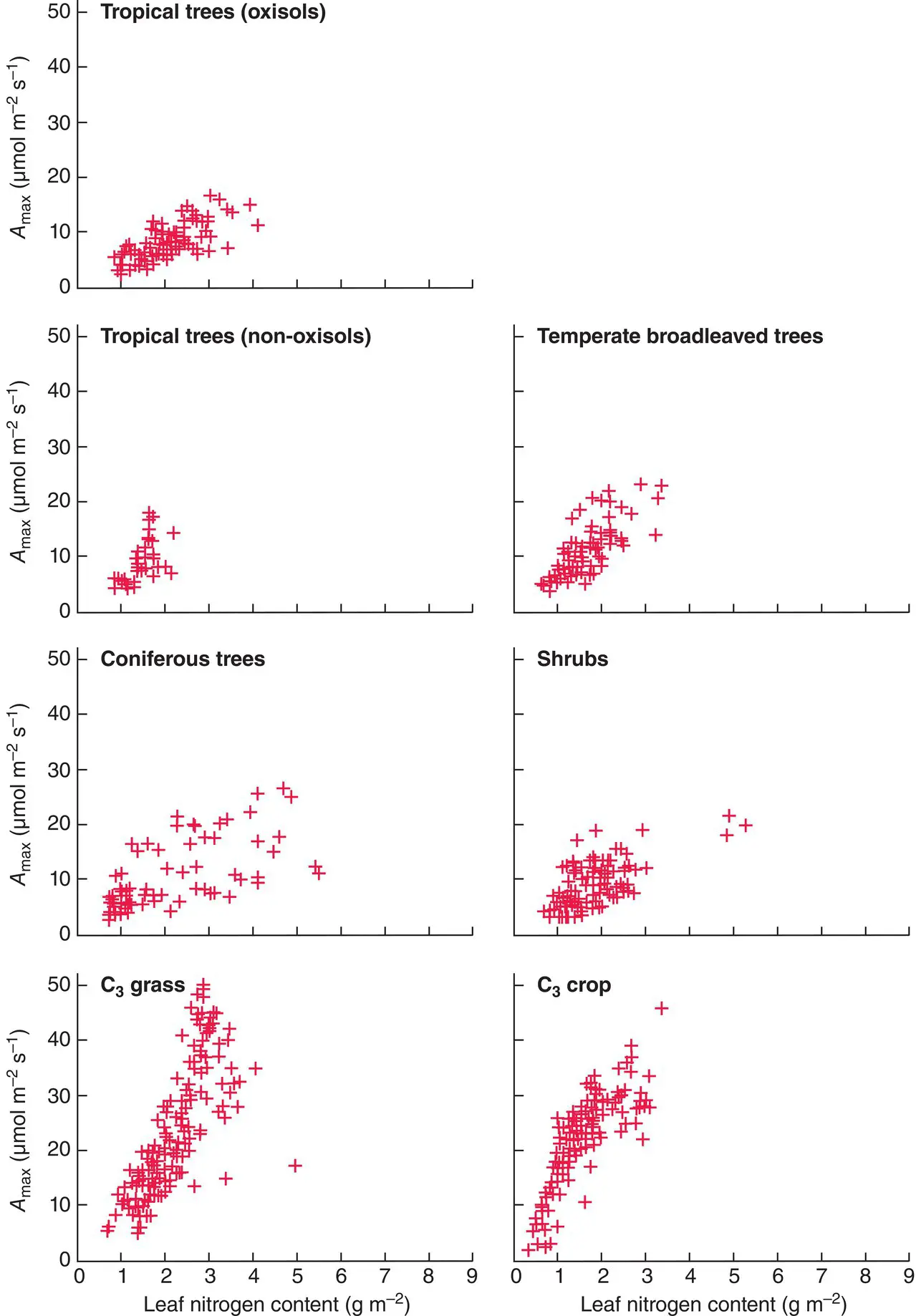
Figure 3.8 Photosynthetic capacity increases with leaf nitrogen content.The positive relationship of photosynthetic capacity ( A max) with the leaf nitrogen content of different C 3plant species, arranged in groups, as indicated. (Oxisols are nutrient‐poor soils dominated by iron oxides, quartz and highly weathered clay minerals such as kaolinite.)
Source : Modified from Kattge et al . (2009).
An example of what can drive variation in photosynthetic capacity is provided by a study of tree species from the forests of Rwanda that were either characteristic of open, clear ground (‘pioneer’ species) or of closed, crowded canopies (‘climax’ species) (see Section 15.4 for a discussion of community successions). The pioneer trees, adapted to life in the sun, had much greater photosynthetic capacity, especially in the case of leaves from the top of the canopy ( Figure 3.9a, b). However, contrary to the general pattern described above, this was not simply the result of a greater investment in those leaves in terms of either nitrogen or phosphorus ( Figure 3.9c, d). Rather, resources in the shade leaves of climax species were directed towards improvements in the ability to harvest what light was available, by having more chlorophyll ( Figure 3.9e), whereas resources in the sun leaves of pioneer species were directed towards increased carboxylation capacity – being able to make best use of high light levels ( Figures 3.9a, b). Overall there was a trade‐off between photosynthetic carboxylation capacity and light‐harvesting ability.
Читать дальше
